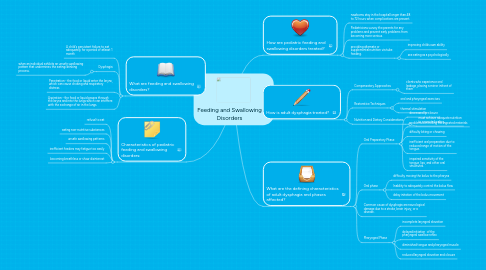
1. What are feeding and swallowing disorders?
1.1. A child's persistent failure to eat adequately for a period of atleast 1 month
1.2. Dysphagia
1.2.1. when an individual exhibits an unsafe swallowing pattern that undermines the eating/drinking process.
1.3. Penetration - the food or liquid enter the larynx, which can cause choking and respiratory distress
1.4. Aspiration - the food or liquid passes through the larynx and into the lungs which can interfere with the exchange of air in the lungs.
2. Characteristics of pediatric feeding and swallowing disorders:
2.1. refusal to eat
2.2. eating non-nutritive substances
2.3. unsafe swallowing patterns
2.4. inefficient feeders may fatigue too easily
2.5. becoming breathless or show disinterest
3. How are pediatric feeding and swallowing disorders treated?
3.1. newborns stay in the hospital longer than 48 to 72 hours when complications are present.
3.2. Pediatricians survey the parents for any problems and prevent early problems from becoming more serious.
3.3. providing alternate or supplemental nutrition via tube feeding.
3.3.1. improving childs own ability
3.3.2. see eating as a psychologically
4. How is adult dysphagia treated?
4.1. Compensatory Approaches
4.1.1. clients who experience oral leakage, placing a mirror infront of them
4.2. Restorative Techniques
4.2.1. oral and pharyngeal exercises
4.2.2. thermal stimulation
4.3. Nutrition and Dietary Considerations
4.3.1. must achieve adequate nutrition to promote healing
5. What are the defining characteristics of adult dysphagia and phases affected?
5.1. Oral Preparatory Phase
5.1.1. decreased lip closure
5.1.2. problems controlling the ingested materials
5.1.3. dificulty biting or chewing
5.1.4. inefficient oral preparation due to reduced range of motion of the tongue.
5.1.5. impaired senstivity of the tongue, lips, and other oral structures.
5.2. Oral phase
5.2.1. difficulty moving the bolus to the pharynx
5.2.2. Inability to adequately control the bolus flow
5.2.3. delay initation of the bolus movement
5.3. Common cause of dysphagia are neurological damage due to a stroke, brain injury, or a disease.
5.4. Pharyngeal Phase
5.4.1. incomplete laryngeal elevation
5.4.2. delayed initiation of the pharyngeal swallow reflex
5.4.3. diminished tongue and pharyngeal muscle
5.4.4. reduced laryngeal elevation and closure
